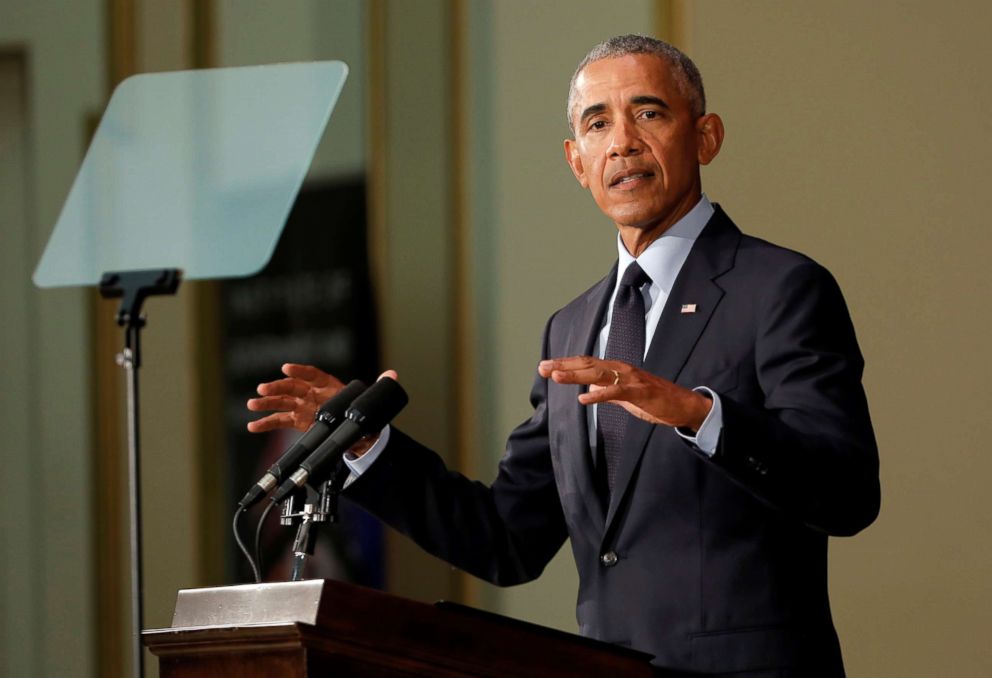https://amgreatness.com/2018/09/07/the-banality-of-barack/
September 7, 2018

Former President Barack Obama speaks at the University of Illinois Urbana-Champaign.
(John Gross/Reuters)
Capping off a week where Senate Democrats embarrassed themselves at what should have been the semi-serious vetting of a Supreme Court justice, along comes our foot-stomping former president to remind Americans of who, ultimately, is responsible for infantilizing national politics.
While lecturing college students assembled in an auditorium in central Illinois—the adopted home state he rarely visits—Barack Obama engaged in the type of vacuous, preening, pretentious, and meaningless soliloquy that once upon a time was accepted as thoughtful political discourse. But it was a temper tantrum disguised as a sermon. He might as well as gone on stage in Champaign and said, “Trump is a big fat meanie!”
Listening to Obama speak is the auditory equivalent of eating cotton candy. It looks sweet and pretty at first, and momentarily it tickles your tongue with the first taste. But it quickly dissolves in your mouth, leaving behind an odd aftertaste. Your hunger isn’t satisfied; you kick yourself for wasting the calories, and you move on to the carnival hot dog. (Yes, these metaphors are intentional.)
Friday’s speech was yet another reminder of why Donald Trump won in 2016: Voters rejected Barack Obama as much as they rejected Hillary Clinton. After a decade of binging on this skilled politician’s oratory cocktail of empty platitudes, self-puffery, and finger-wagging scoldings, we were burned out. Americans started to notice that the soaring rhetoric did not match the accomplishments. There was a creeping sense the same man who once promised his vision was “not red states or blue states, just the United States” had done more damage to the body politic than any other president in recent memory.
And he wasn’t even a good tactician for his own side. In fact, while this political mastermind was in the Oval Office, his party lost more than 1,000 seats to Republicans across the country.
Not an Ounce of Self-Awareness
One might imagine that suffering one political humiliation after another would humble this former community organizer. That handing over the keys to the most powerful office in the world to someone with zero political experience—who questioned your birth certificate and publicly mocked your presumed successor—then systematically disassembled every key achievement of your administration while the economy responded in delight would make you reconsider your approach. Maybe a true statesman would spend two years in exile reexamining what went wrong on his watch and offer a few mea culpas to the political party—and to the country—he helped diminish.
But there is no indication Barack Obama has learned any lessons from 2016. His speech (while he was accepting an ethics award, no less) was a weary remix of Obama’s Greatest Hits. It’s not just that Obama is petulant and demeaning. It’s not that he gets away with the very name-calling and ridicule that Trump gets blasted for.
The bottom line is Obama is a bore. His banality is reflective of the wider Democratic Party malaise. There is no inspiring message or even policy prescription. It’s wholly reliant on tropes about race and class and fear. It’s filled with potshots at the other side while pretending to be above-it-all and morally superior. The chin held high in the air as he speaks is not accidental: Obama is pretending to be just like you, but believes deep down he is far better.
Well-Worn Complaints
Far from the speech being the “greatest, most timely, and most important in the history of this country” as one Democratic activist described it, Obama’s speech sounded like an updated version of every speech he’s given in the past few years. It was filled with whiny platitudes about moments in time and stark choices and inequality and demagogues. He veered between warnings about fake patriotism while insisting it’s our civic duty to vote the way he wants. He pouted about not getting credit for the country’s booming economy. Both sides are culpable for the current political divide, Obama admitted, but Republicans are much more to blame. (Perhaps he missed this week’s spectacle at the Kavanaugh hearings.)
He trotted out the same well-worn complaints about voting rights and climate change. Solutions always come with a price, such as a carbon tax and higher minimum wage. After eight years of trying, he still can’t come up with a convincing sell on how to fix the nation’s failing immigration system: “Democrats talk about reforming our immigration system so, yes, it is orderly and it is fair and it is legal but it continues to welcome strivers and dreamers from all around the world.” Huh?
There were more nuggets of nothingness: A vacuum in democracy. The politics of fear. Stand up to bullies not follow them. We need more women in charge. The best way to protest is to vote. Walls don’t keep out threats like terrorism or disease.
Pretty boring stuff from a guy who is widely considered by the media as one of the greatest presidential orators of all time. It’s doubtful that Chris Matthews felt a thrill up his leg as he listened to this snoozer.
He Goes Low
It wouldn’t be Obama if he didn’t land some low punches at his political foes. This is one of the most overlooked characteristics of the former president: He is as petty and petulant as the current one.
Capitalizing on one of the big news stories of the week, Obama brought up the anonymous op-ed in theNew York Times allegedly authored by a senior official in the Trump administration: “The claim that everything will turn out OK because there are people inside the White House who secretly aren’t following the president’s orders, that is not a check. That’s not how our democracy is supposed to work,” Obama said. “They’re not doing us a service by actively promoting ninety percent of the crazy stuff that’s coming out of this White House, and then saying, ‘Don’t worry, we’re preventing the other 10 percent.’”
So much for civil norms about a previous president not criticizing a sitting president.
Obama now is threatening to campaign for Democratic candidates nationwide, an effort that has been snubbed by some incumbents fighting for reelection in states won by Donald Trump. Perhaps those Democrats know something Obama does not. His powers of political persuasion are gone, torched by a Manhattan business man and reality TV star he once publicly taunted never would be president. It looks like Obama, now as always, is the last to know.




